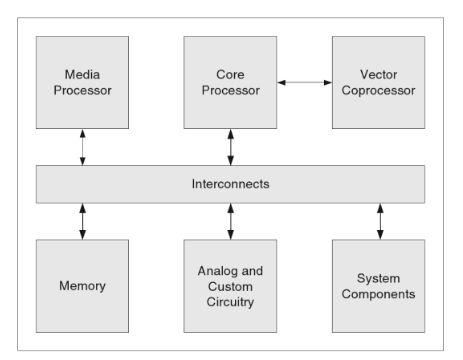
what is an SoC?
In this article, I have discussed about System on Chips (SoC) and their Applications. An SoC, or System on a Chip, is a type of integrated circuit that integrates all components of a computer or electronic system into a single chip. It typically includes a central processing unit (CPU), memory, input/output interfaces, and other components all on a single piece of silicon. This allows for smaller, more efficient devices and reduces the cost of manufacturing.
SoC Suppliers
There are several companies that manufacture and supply System on a Chip (SoC) products. Some of the major suppliers in the market include:
Qualcomm: Qualcomm is a leading provider of mobile SoCs, which are used in smartphones and other mobile devices.
Samsung: Samsung is a major supplier of SoCs for a variety of devices, including smartphones, tablets, and televisions.
MediaTek: MediaTek is a Taiwan-based company that supplies SoCs for mobile devices, particularly in the Asian market.
Intel: Intel Corporation is a supplier of SoCs for personal computers, laptops and servers, and embedded systems
Broadcom: Broadcom is a supplier of SoCs for a variety of applications, including networking, storage, and video processing.
Nvidia: Nvidia is a supplier of SoCs for AI, Robotics and Gaming.
Apple: Apple designs and manufactures its own SoCs for its devices, such as the iPhone, iPad, and Mac computers.
These are just a few examples of companies that supply SoCs. There are many other manufacturers in the market as well.
SoC Technologies
There are several technologies that are commonly used in the design and manufacture of System on a Chip (SoC) products. Some of these include:
FinFET Technology: FinFET is a type of 3D transistor that allows for smaller, more efficient SoCs.
ARM Cortex-A Processors: ARM Cortex-A processors are a popular choice for SoC designs, as they are efficient and provide a wide range of performance options.
GPU Technologies: Graphics Processing Units (GPUs) are increasingly being integrated into SoCs to handle tasks such as image and video processing, and AI workloads
Heterogeneous System Architecture (HSA): HSA is a technology that allows different types of processors to work together on the same SoC, such as CPU, GPU and DSP, optimizing the power and performance of the device
Low Power Design: SoCs are designed to consume less power, to prolong battery life and to reduce heat dissipation.
Wireless Technologies: SoCs can also include wireless technologies such as Bluetooth, WiFi and NFC, which allow devices to communicate with other devices without a physical connection.
Packaging Technologies: SoCs are also designed with different packaging technologies, such as Flip-Chip, Package-on-package (PoP) and System-in-package (SiP) to accommodate different form factors and to reduce the size of the device.
SoC Application in IoT
System on a Chip (SoC) technology is widely used in the Internet of Things (IoT) due to its small size, low power consumption, and high performance capabilities. Some examples of SoC applications in IoT include:
Smart home devices:
SoCs are used in smart home devices such as thermostats, security cameras, and smart lights to control and monitor the devices.
Wearables:
SoCs are used in wearables such as smartwatches and fitness trackers to track fitness data, monitor heart rate, and perform other functions.
Smart Cities:
SoCs are used in smart city infrastructure such as traffic lights, parking meters, and public transportation to improve efficiency and reduce costs.
Industrial IoT:
SoCs are used in industrial equipment and machinery such as robots, drones, and manufacturing equipment to monitor and control the devices.
Agricultural IoT:
SoCs are used in precision agriculture to monitor crop growth, soil moisture, and weather conditions to optimize crop yields.
Automotive IoT:
SoCs are used in vehicles to enable features such as lane departure warning, automatic emergency braking, and autonomous driving.
SoC and Future Trends
System on a Chip (SoC) technology is constantly evolving and improving, and there are several trends that are shaping the future of SoCs. Some of these trends include:
Increased Integration:
SoCs are becoming increasingly integrated, with more and more components being included on a single chip. This includes adding specialized processors such as GPUs and DSPs, as well as integrating memory and other components. This leads to smaller, more efficient devices.
Artificial Intelligence (AI) and Machine Learning (ML):
SoCs are incorporating AI and ML capabilities, allowing devices to perform tasks such as image recognition, natural language processing, and decision-making. This trend is expected to continue as the demand for AI-enabled devices increases.
5G and mmWave:
SoCs are also incorporating 5G and mmWave technologies to enable faster data transfer and support the growing number of IoT devices.
Security:
SoCs are including hardware-based security features to protect against hacking and other security threats. This includes the use of secure boot, secure storage, and secure communication protocols.
Edge Computing:
SoCs are designed to handle the increasing amount of data generated by IoT devices, and to process that data on the edge, near the source, reducing the dependency on the cloud and reducing the latency of the devices.
Power efficiency:
SoCs are being designed to consume less power, prolonging battery life and reducing heat dissipation. This is becoming increasingly important as devices are becoming smaller and used in more remote locations.
Overall, SoC technology is expected to continue to evolve and improve, leading to smaller, more powerful, and more efficient devices that can handle the increasing demands of IoT and AI applications.
Also read here